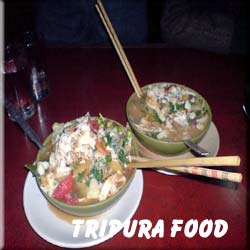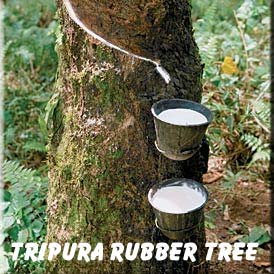CULTURE IS THE ART OF LIVING
The people of Tripura are mostly known as Tripuris and they are mostly tribes. They are mainly of Tibeto-Burmese origin. Their origin dates back to more than 2000 years and it were these Tripuri people who ruled the state of Tripura. The tribal people of Tripura have a very interesting history which states that the people originally belonged to other foreign countries like Tibet and Burma who migrated from there much before 65 AD and settled down in the North Eastern part of the country, namely Tripura. There are records from epics which states that the Tripuri tribes are also known as Puran Tripuri and Dev Varma who had ancestral relation with the lunar dynasty of Mahabharata. The Tripuri tribes scattered mostly in the western and northern parts of the Tripura have also resisted the entry of the Mughal invaders earlier.
The culture of Tripura can be best expressed as comprising the following : ORIGIN AND ETHNICITY
The Tripuri tribes have a mixed economy. The tribes of Tripura who are mostly old fashioned in character have long classifications of class and there is a representative from each clan to discharge certain duties to the royal family of the state. Some of the prominent clans of the Tripuri's are Bachal, Siuk, Koaitoia, Daitys, Singh, Hojoria, Chiltia, Apaia, Chatratoia, Galim, Sube Naran, Sena, Jolai, and Khakloo. Reangs, Jamatias, Chakma, Halam and Usai are the other groups of tribal people living in this area. The population is largely Bengali in spite of 19 Scheduled Tribes.The people of Tripura show a diverse ethnicity with two major racial groups namely the Bengalese who are Indo-Aryans by origin. The Indo-Mongloids are represented by a few other communities like the Tripuris, the Reangs, the Jamatis, the Noatias, the Kukis, the Halams, the Chakma, the Mogh and the Lushai. Apart from the above mentioned major tribes, there are also ten more tribes and these nineteen tribes are collectively classified as 'Scheduled Tribes'. The native inhabitants of the state are known as Tipras and they constitute about 16 percent of the total and 57% of the tribal population of the state.Though the rulers of the initial period were the descendants of the Kshatriyas they got very much influenced by the language, culture and custom of the Bengalis resulted in a breakaway group of the original (Puram) Tripuris and formed a new community called as the Natun Tripuris.The people of the Thakur community are those who are close to the royal family and they are placed high in society with postings like public officials, writers, musicians, engineers and doctors.
CULTURE
The state of Tripura is dominated by the Bengalis and so the prevalent culture is also Bengali. The people of Tripura re noted for a rich cultural heritage with a blend of music, fine arts, performing arts, and handicrafts. The culture as a whole is a blend of various ethno-linguistic groups such as, Tripuris, Jamatia, Reang, Noatia, Koloi, Murasing, Chakma, Halam, Garo, Kuki, Lushai, Mogh, Munda, Oraon, Santhal, and Uchoi. Apart from the tribal community the culture of the Bengali people is widely practiced by the people of Tripura for even the tribal people living in urban areas are slowly getting influenced by the Bengali culture and traditions.
The Tripura kings were great patron of Bengali culture, especially literature and Bengali language was the language of the court. The Bengali literature, music and cuisine are also taken up by the people of Tripura. The culture of the people of Tripura is not complete without the music and dance of the tribal people of the state. All the social and religious gatherings like weddings and other festivals are accompanied by music and dance pertaining to their own tribal community. Some of the main musical instruments used by the people are sarinda, chongpreng, and sumui.The people belonging to the Tripuri and Jamatia tribal community perform goria dance during the Goria puja and Jhum dance in the harvest season. Some of the other tribal dances performed by the people are lebang dance, mamita dance, and mosak sulmani dance.The hojagiri dance performed by young girls balancing on earthen pitchers is very famous pertaining to the Reang community. During the Bizhu festival the Chakmas perform the Bizhu dance. Other tribal dances of the Reang community are wangala dance of the Garo people, hai-hak dance of the Halam branch of Kuki people, sangrai dance and owa dance of the Mog tribe and others. CUSTOMS AND TRADITIONS
Since the people of Tripura belong to a blend of various tribal communities, they follow different customs and traditions. According to the Reang community the marriages are fixed by a matchmaker who is widely known as Andra where he does the initial negotiations between the boy's and the girl's family. When the marriage is finalized the guests are served with pork, rice and rice beer. The wedding is performed by the Ochai. Child marriage is not encouraged in this community and also widow marriage can take place only after one year of the death of the husband. The widow and widower are not allowed to participate in any social or religious gathering one year after the death of their spouses. A widow is not allowed to wear any ornaments after the death of her husband. They do not have any dowry system but however the groom has to spend for two years to the father- in -laws' house before the wedding. At the birth of a child as a matter of thanking the god several pujas are performed for the safe growth of the child and sacrifices are also done to please the god. When a person dies his or her body is first washed with soap and water and then with the water which is got from the cleaning of the raw rice. After which they are dressed up neatly with their traditional attires and in case of a female, a fowl is sacrificed near the feet of the deceased. The body is left the whole night during which the ritual of dance is performed and the mourners are given rice beer to drink. After this the next day morning the body is cremated near a stream. Some of the tribes still cling on to quaint customs like floating colorful parasols in ponds to honour the dead.COSTUMES
The traditional costume of a male in Tripura is 'rituku' for the loin and 'kamchwlwi borok' for the upper part of the body. Sometime these are topped off by a self-woven shirt, called Kubai. But however now in urban areas with modernization there are lot of western influence in the costumes. Rinai is a piece of long cloth which is used by the women of Tripura to drape it around their waist and it goes up to their knee. Risa is considerably a small piece of cloth to that of the Rinai and is used to cover the entire chest area of the body. The Risas are usually designed with beautiful embroidery work. Risa is supposed to be a traditional attire worn by women belonging to a particular clan. The women of Tripura adorn themselves with plethora of beads and coin strands in their necks. During dance performances the female performers wear a head gear which is made of coronal, made of brass and colored cane, further embellished with porcupine quills. Green feathers of the parrot`s wings, decorated at their tips, with tussocks of contrasting red wool decorate the upper edge of the quill. They generally prefer silver ornaments like chains made of coins, bangles, ear and nose rings.
CUISINE

OCCUPATION

FAMOUS PERSONALITIES
Dinesh Nandan Sahay -former Governor of Tripura and Governor of Chhatisgarh. He was the first governor of Chhatisgarh state from 2000 to 2003.Lallan Prasad Singh -Governor of Assam (1973–80), Manipur (1973–80, 1982–83), Meghalaya (1973–80), Nagaland (1973–81), and Tripura (1973–80). He was awarded Padma Vibhushan award in 1999 after his death.He served a long and distinguished career in the Indian Administrative Service (Indian Civil Service in his time). L.P. Singh was Chief Secretary during first Independent government of Bihar (1946–61).
Raima Sen -(born Raima Dev Varma on 11 November 1979) is an Indian film actress.
Moon Moon Sen-Indian film actress. She did movies in Bengali, Hindi, Tamil, Telugu, Malayalam, Marathi and Kannada films. Sen is part of a three generational family of actors and was a staple of the Bengali film industry, starring in many hit films.


